The Intelligent Lighting Control Market is estimated to be valued at USD 36.3 billion in 2025 and is projected to reach USD 167.0 billion by 2035, registering a compound annual growth rate (CAGR) of 16.5% over the forecast period.
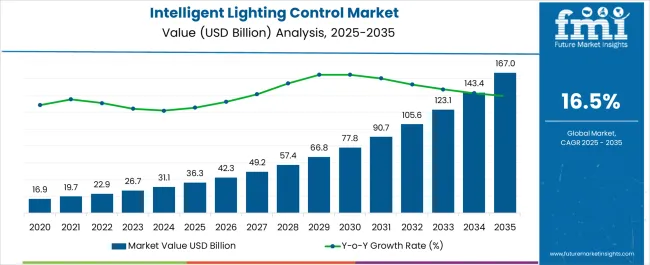
| Metric | Value |
|---|---|
| Intelligent Lighting Control Market Estimated Value in (2025 E) | USD 36.3 billion |
| Intelligent Lighting Control Market Forecast Value in (2035 F) | USD 167.0 billion |
| Forecast CAGR (2025 to 2035) | 16.5% |
The intelligent lighting control market is experiencing strong growth, supported by increasing demand for energy-efficient solutions, sustainability initiatives, and the rising integration of smart technologies in residential, commercial, and industrial infrastructure. Governments and regulatory bodies worldwide are enforcing strict energy consumption standards, creating significant opportunities for intelligent lighting systems that reduce power usage while enhancing user experience. Rapid advancements in IoT, AI, and sensor-based technologies are enabling more responsive and adaptive lighting environments, further fueling adoption across diverse sectors.
The growing emphasis on smart cities and digital building infrastructure is reinforcing the integration of intelligent lighting controls into broader building management systems. Increasing consumer awareness about energy conservation, coupled with rising electricity costs, is also stimulating demand.
Furthermore, the scalability and flexibility of intelligent lighting solutions are making them a preferred choice for both retrofit and new construction projects As urbanization accelerates and the focus on sustainability intensifies, the market is anticipated to expand rapidly, with manufacturers investing in innovative technologies to meet evolving efficiency and automation requirements.
The intelligent lighting control market is segmented by component type, connection type, end user, and geographic regions. By component type, intelligent lighting control market is divided into Intelligent Luminaires, Sensors, Ballast and LED Drivers, Micro Controllers, Dimmers and Switch Actuators, and Transmitters & Receivers. In terms of connection type, intelligent lighting control market is classified into Wireless and Wired. Based on end user, intelligent lighting control market is segmented into Commercial Buildings, Residential Buildings, and Public Utilities. Regionally, the intelligent lighting control industry is classified into North America, Latin America, Western Europe, Eastern Europe, Balkan & Baltic Countries, Russia & Belarus, Central Asia, East Asia, South Asia & Pacific, and the Middle East & Africa.
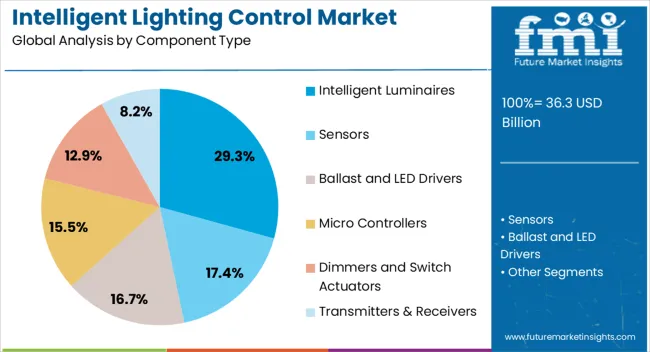
The intelligent luminaires segment is projected to hold 29.3% of the intelligent lighting control market revenue share in 2025, positioning it as the leading component type. Its dominance is being driven by the ability to integrate sensors, controllers, and connectivity modules directly into the luminaire, allowing for seamless operation and automation. Intelligent luminaires deliver significant energy savings by adjusting brightness levels, color temperature, and operating schedules based on occupancy and daylight availability.
Their role in supporting sustainable building certifications and compliance with energy efficiency regulations is reinforcing adoption. Continuous innovation in LED technology and the development of tunable white and human-centric lighting features are adding further value to this segment.
The growing demand from commercial and institutional facilities for advanced lighting systems that enhance user comfort and productivity is also strengthening the segment’s market share As the shift toward connected and intelligent lighting ecosystems accelerates, luminaires with embedded intelligence are expected to remain the preferred choice for large-scale deployments.
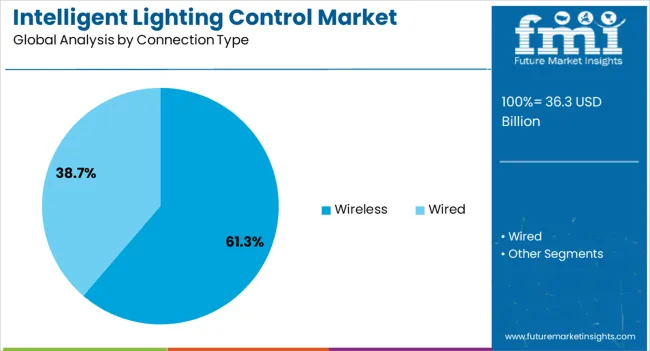
The wireless connection type segment is expected to account for 61.3% of the intelligent lighting control market revenue share in 2025, making it the dominant connection method. Its leadership is being supported by the rising preference for flexible and cost-effective installation options that eliminate the need for extensive cabling infrastructure. Wireless lighting controls are offering scalability and ease of integration into existing buildings, making them highly suitable for retrofits as well as new constructions.
The ability to connect seamlessly with other IoT-enabled devices and building management platforms is reinforcing their adoption in smart buildings and urban projects. Continuous advancements in wireless protocols such as Zigbee, Bluetooth Mesh, and Wi-Fi are enhancing reliability, security, and interoperability, which are critical for large-scale deployments.
The segment’s growth is also supported by the demand for systems that can be remotely monitored and controlled through mobile devices, providing convenience and efficiency As organizations prioritize digital transformation and intelligent infrastructure, wireless connectivity is expected to remain the cornerstone of intelligent lighting control solutions.

The commercial buildings segment is projected to capture 50.3% of the intelligent lighting control market revenue share in 2025, establishing itself as the leading end-user category. This dominance is being reinforced by the strong emphasis on reducing operational costs, enhancing occupant comfort, and meeting sustainability goals in commercial infrastructure. Intelligent lighting systems in office complexes, retail spaces, hospitality facilities, and educational institutions are being adopted to optimize energy consumption while improving the overall user environment.
The ability of these systems to integrate with building automation platforms allows for multi-functional management, including HVAC and security systems, creating holistic smart building ecosystems. Growing investment in green buildings and compliance with stringent energy efficiency certifications are accelerating demand.
Commercial real estate developers and facility managers are prioritizing intelligent lighting to achieve long-term cost savings and enhance property value As urbanization continues and smart city initiatives gain momentum, the commercial sector is expected to maintain its leadership, supported by widespread adoption of advanced lighting technologies that align with digital and sustainability objectives.
Government restrictions on the usage of energy-efficient products also help the industry expand. The expansion of these systems has been constrained, nevertheless, by the higher installation costs and longer payback times of LED lights. Future developments in low-cost sensors and falling LED product costs would reduce installation costs, opening up a wide range of growth prospects for the market for intelligent lighting controls.
To reduce CO2 emissions and encourage efficient power use and management, the governments of many nations have launched several projects. As these systems enable effective use of power in lighting with low wastage, supporting government measures helps to fuel the growth of the intelligent lighting controls market.
With mandatory regulations imposed by the governments of respective regions, regions like the USA, the UK, China, and India are demonstrating a prominent demand for intelligent lighting controls, which is anticipated to offer lucrative opportunities for the intelligent lighting controls market globally.
The idea of smart cities is spreading throughout many areas, and several government programs promote this movement. Since a linked system makes up a smart city, automated lighting systems are necessary for general lighting applications. Sensor-based control systems are used in these automated lighting systems. As a result, companies in the intelligent lighting control industry are projected to see high demand during the forecast period.
Commercial buildings, residential structures, and public utilities are among the popular end users of intelligent lighting controls. The revenue from commercial buildings accounts for around 58% of the total market revenue. Due to increased electricity usage and a higher emphasis on energy management to save electricity costs, intelligent lighting controls system manufacturers are anticipated to witness lucrative growth opportunities.
The key trend of global intelligent lighting control market is the tremendous increment in the demand of intelligent lighting control in the commercial buildings.
There are various factors driving the growth of global Intelligent lighting control market such as the advantages provided by Intelligent lighting control system over the traditional switch operated lighting systems; it is more economic and energy efficient, it provides better experience to the users as compare to the traditional lighting system, other drivers include robust demand from the residential sectors, declining price of light emitting diode source of light gives rise to the adoption of intelligent lighting control system, also the government favorable policies to use LED lighting instead of other luminaries are driving the growth of global intelligent lighting control market.
On the other side, there are some factors which are responsible to hinder the growth of global intelligent lighting control market, one of them is the lack of knowledge regarding the installation cost of whole intelligent lighting control system and payback period of the same.
Segmentation of intelligent lighting control market is done on the basis of component type, connection type, end user and Geography. On the basis of component type, global intelligent lighting control market is segmented into following segments; sensors, ballast and LED drivers, micro controllers, dimmers and switch actuators, transmitters & receivers and intelligent luminaries.
On the basis of the connection type, global intelligent lighting system market is segmented into wired and wireless, among which wireless system is more popular as it requires less space and also provides quick response as compared to former one.
On the basis of end user, global intelligent lighting control market is segmented into following segments; commercial buildings, residential buildings and public utilities. Among these three segments, commercial buildings segment comprises maximum market share, which is even more than 40% of total market size.
On the basis of Geography, Intelligent lighting control market is segmented into seven regions which are ; North America, Latin America, Western Europe, Eastern Europe, Japan, Asia Pacific Excluding Japan (APEJ), and Middle East and Africa (MEA).
Among all the seven region, North America is the highest contributor in term of revenue in global intelligent lighting control market, and it is estimated that Asia Pacific is the fastest growing market for intelligent lighting control provider across the globe during forecast period.
The report is a compilation of first-hand information, qualitative and quantitative assessment by industry analysts, inputs from industry experts and industry participants across the value chain. The report provides in-depth analysis of parent market trends, macro-economic indicators and governing factors along with market attractiveness as per segments. The report also maps the qualitative impact of various market factors on market segments and geographies.
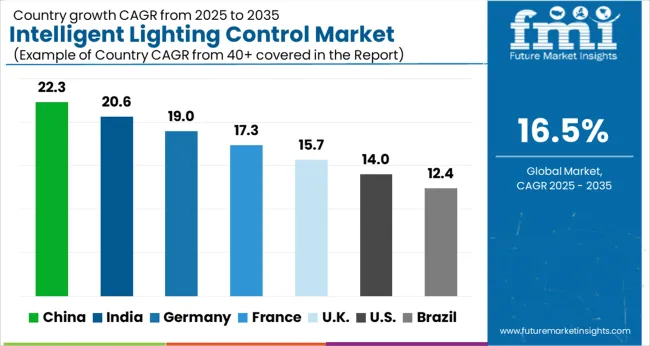
| Country | CAGR |
|---|---|
| China | 22.3% |
| India | 20.6% |
| Germany | 19.0% |
| France | 17.3% |
| UK | 15.7% |
| USA | 14.0% |
| Brazil | 12.4% |
The Intelligent Lighting Control Market is expected to register a CAGR of 16.5% during the forecast period, exhibiting varied country level momentum. China leads with the highest CAGR of 22.3%, followed by India at 20.6%. Developed markets such as Germany, France, and the UK continue to expand steadily, while the USA is likely to grow at consistent rates. Brazil posts the lowest CAGR at 12.4%, yet still underscores a broadly positive trajectory for the global Intelligent Lighting Control Market. In 2024, Germany held a dominant revenue in the Western Europe market and is expected to grow with a CAGR of 19.0%. The USA Intelligent Lighting Control Market is estimated to be valued at USD 13.1 billion in 2025 and is anticipated to reach a valuation of USD 48.6 billion by 2035. Sales are projected to rise at a CAGR of 14.0% over the forecast period between 2025 and 2035. While Japan and South Korea markets are estimated to be valued at USD 1.7 billion and USD 1.1 billion respectively in 2025.
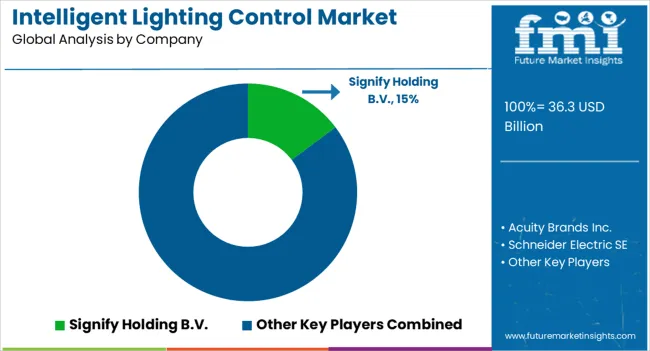
| Item | Value |
|---|---|
| Quantitative Units | USD 36.3 Billion |
| Component Type | Intelligent Luminaires, Sensors, Ballast and LED Drivers, Micro Controllers, Dimmers and Switch Actuators, and Transmitters & Receivers |
| Connection Type | Wireless and Wired |
| End User | Commercial Buildings, Residential Buildings, and Public Utilities |
| Regions Covered | North America, Europe, Asia-Pacific, Latin America, Middle East & Africa |
| Country Covered | United States, Canada, Germany, France, United Kingdom, China, Japan, India, Brazil, South Africa |
| Key Companies Profiled | Signify Holding B.V., Acuity Brands Inc., Schneider Electric SE, Honeywell International Inc., ams-OSRAM AG, Lutron Electronics Co. Inc., General Electric Company, Panasonic Corporation, Hubbell Incorporated, Leviton Manufacturing Co. Inc., Control4 Corporation (Snap One LLC), and Enlighted Inc. |
The global intelligent lighting control market is estimated to be valued at USD 36.3 billion in 2025.
The market size for the intelligent lighting control market is projected to reach USD 167.0 billion by 2035.
The intelligent lighting control market is expected to grow at a 16.5% CAGR between 2025 and 2035.
The key product types in intelligent lighting control market are intelligent luminaires, sensors, ballast and led drivers, micro controllers, dimmers and switch actuators and transmitters & receivers.
In terms of connection type, wireless segment to command 61.3% share in the intelligent lighting control market in 2025.






Full Research Suite comprises of:
Market outlook & trends analysis
Interviews & case studies
Strategic recommendations
Vendor profiles & capabilities analysis
5-year forecasts
8 regions and 60+ country-level data splits
Market segment data splits
12 months of continuous data updates
DELIVERED AS:
PDF EXCEL ONLINE
Intelligent Road Test Instruments Market Size and Share Forecast Outlook 2025 to 2035
Intelligent Driving Technology Solution Market Size and Share Forecast Outlook 2025 to 2035
Intelligent Completion Market Size and Share Market Forecast and Outlook 2025 to 2035
Intelligent Rubber Tracks Market Size and Share Forecast Outlook 2025 to 2035
Intelligent Cervical Massager Market Size and Share Forecast Outlook 2025 to 2035
Intelligent Garment Hanging Conveyor System Market Size and Share Forecast Outlook 2025 to 2035
Intelligent Rotary Kiln Monitoring Systems Market Size and Share Forecast Outlook 2025 to 2035
Intelligent Multifunctional Laser Bird Repeller Market Size and Share Forecast Outlook 2025 to 2035
Intelligent Platform Management Interface (IPMI) Market Size and Share Forecast Outlook 2025 to 2035
Intelligent Flow Meter Market Size and Share Forecast Outlook 2025 to 2035
Intelligent Enterprise Data Capture Software Industry Analysis in Japan Size and Share Forecast Outlook 2025 to 2035
Intelligent Vending Machine Market Insights – Demand, Size & Industry Trends 2025–2035
Intelligent Transportation System Market Analysis - Size, Share, and Forecast Outlook 2025 to 2035
Intelligent Virtual Store Design Solution Market Size and Share Forecast Outlook 2025 to 2035
Intelligent Enterprise Data Capture Software Market Size, Growth, and Forecast 2025 to 2035
Intelligent Fencing Market Size and Share Forecast Outlook 2025 to 2035
Intelligent Packaging Market Analysis - Size, Share, and Forecast Outlook 2025 to 2035
Intelligent Enterprise Data Capture Software Market in Korea – Trends & Forecast 2025 to 2035
Intelligent Power Module Market Trends - Growth & Forecast 2025 to 2035
Intelligent Prosthetics Market Analysis - Size, Share, and Forecast 2025 to 2035

Thank you!
You will receive an email from our Business Development Manager. Please be sure to check your SPAM/JUNK folder too.
Chat With
MaRIA